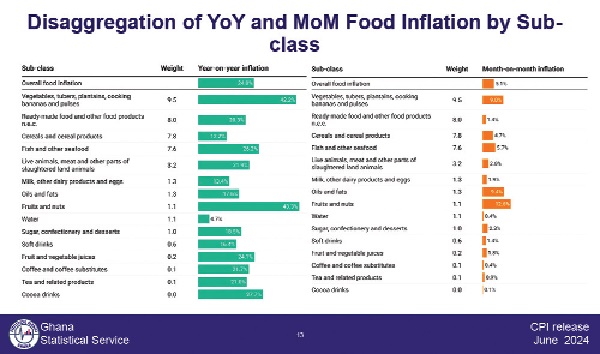
Food inflation inches up to 24%
Food inflation continues to be a major concern for the country, wit the rate increasing from 22.6% in May to 24% in June.
Non-food inflation on the other hand dropped from 23.6% to 21.6% in June 2024.
Overall inflation also eased to 22.8% from 23.1%, the lowest in almost two years.
CPI
According to the latest figures released by the Ghana Statistical Service (GSS), the Consumer Price Index (CPI), which measures changes in the price of a fixed basket of goods and services purchased by households, for June 2024 was 226.4 relative to 184.4 for June 2023, indicating that year-on-year (YoY) rate of inflation for June 2024 was 22.8 per cent
This means that in the month of June 2024 the general price level was 22.8 per cent higher than June 2023, while the month-on-month (MoM) inflation between May and June 2024 stood at 2.9 per cent
Measurement
In arriving at the June rate, GSS collected prices in 57 markets. Prices were also collected from about 8,337 outlets.
It said prices are collected for approximately 47,800 products every month from 16 regions while products are ordered in a hierarchy of 13 divisions, 44 groups, 98 classes, 156 subclasses and 307 items.
“Every item can only be part of one subclass, and every subclass can only be part of one class,” the GSS said.
Exchange rate impact
Government Statistician, Professor Samuel Kobina Annim, highlighted the impact of exchange rate fluctuations on imported goods.
Inflation for imported items stood at 17.5 per cent, potentially linked to the recent period of cedi instability.
However, Prof. Annim pointed to a trend analysis showing some recent stabilisation in the exchange rate, which could contribute to further inflation reduction.
“The question on the exchange rate is always an important one that is why we have provided a trend analysis from June 2023 to June 2024. The dominance of the inflation on imported items can be aligned to the exchange rate stability “, he said.
Caution
The Government Statistician cautioned that while the overall picture shows improvement, disparities persist across regions and product categories.
For instance he said, four sectors – alcoholic beverages, tobacco and narcotics, restaurants and accommodation services, and housing, water and electricity – recorded inflation rates higher than the national average.
Additionally, the Upper East Region continues to experience the highest inflation rate at 35.2 per cent, while the Oti Region boasted the lowest at 12.5 per cent.
Focus
Earlier in an interview at the Executive Studios of the Graphic Communications Group Ltd, Prof. Anim stressed the need for governments to focus attention on items within the inflation basket which have heavier weights that cause inflation to go.
He was of the strong believe that, if that was done consistently, the country would make a lot more progress in its attempt to bring inflation rate within the target band.
